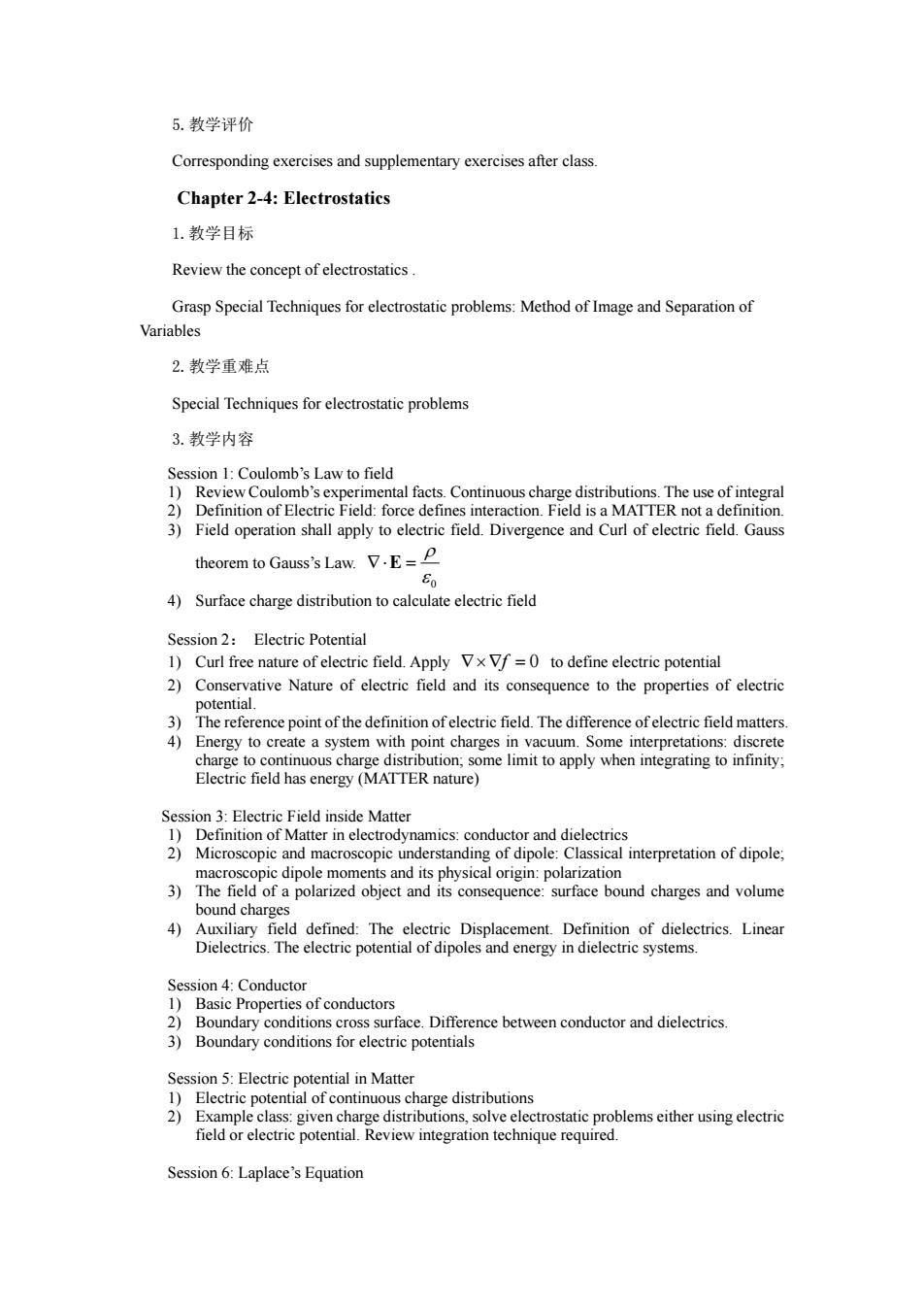正在加载图片...

5.教学评价 Corresponding exercises and supplementary exercises after class Chapter 2-4:Electrostatics 1.教学目标 Review the concept of electrostatics Grasp Special Techniques for electrostatic problems:Method of Image and Separation of Variables 2.教学重难点 Special Techniques for electrostatic problems 3.教学内容 al facts Continuous ch e distributions The use of integral 3)Field operation shall apply to electric field.Divergence and Curl of electric field.Gauss theorem to Gauss's Law.V.E=P 4)Surface charge distribution to calculate electric field Session2: Electric Po 1)Curl free nature of electric field.Apply Vx=to define electric potential 2)Conservative Nature of electric field and its consequence to the properties of electric Thereference pont of thedefntionffield.Thefferefiematters 4)Energy to create a syste Electric field has energy (MATTER nature) :1 namics:conductor and dielectrics 2)Microscopic and macroscopic understanding of dipole:Classical interpretation of dipole ound charges and volume bound charg defined electric poten 2)Boundary conditions cross surface.Difference between conductor and dielectrics. 3)Boundary conditions for electric potentials Session 5 Flectrie notential in Matter ential of continuous charge distributions eopec eelCPabltemseiherusingelectnc Session 6:Laplace's Equation5.教学评价 Corresponding exercises and supplementary exercises after class. Chapter 2-4: Electrostatics 1.教学目标 Review the concept of electrostatics . Grasp Special Techniques for electrostatic problems: Method of Image and Separation of Variables 2.教学重难点 Special Techniques for electrostatic problems 3.教学内容 Session 1: Coulomb’s Law to field 1) Review Coulomb’s experimental facts. Continuous charge distributions. The use of integral 2) Definition of Electric Field: force defines interaction. Field is a MATTER not a definition. 3) Field operation shall apply to electric field. Divergence and Curl of electric field. Gauss theorem to Gauss’s Law. 0 E 4) Surface charge distribution to calculate electric field Session 2: Electric Potential 1) Curl free nature of electric field. Apply f 0 to define electric potential 2) Conservative Nature of electric field and its consequence to the properties of electric potential. 3) The reference point of the definition of electric field. The difference of electric field matters. 4) Energy to create a system with point charges in vacuum. Some interpretations: discrete charge to continuous charge distribution; some limit to apply when integrating to infinity; Electric field has energy (MATTER nature) Session 3: Electric Field inside Matter 1) Definition of Matter in electrodynamics: conductor and dielectrics 2) Microscopic and macroscopic understanding of dipole: Classical interpretation of dipole; macroscopic dipole moments and its physical origin: polarization 3) The field of a polarized object and its consequence: surface bound charges and volume bound charges 4) Auxiliary field defined: The electric Displacement. Definition of dielectrics. Linear Dielectrics. The electric potential of dipoles and energy in dielectric systems. Session 4: Conductor 1) Basic Properties of conductors 2) Boundary conditions cross surface. Difference between conductor and dielectrics. 3) Boundary conditions for electric potentials Session 5: Electric potential in Matter 1) Electric potential of continuous charge distributions 2) Example class: given charge distributions, solve electrostatic problems either using electric field or electric potential. Review integration technique required. Session 6: Laplace’s Equation